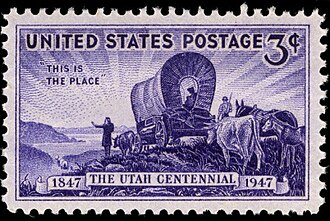
Utah’s history is shaped by the interplay between its rugged landscapes, the Indigenous peoples who first called it home, the explorers who charted its terrain, and the settlers who built thriving communities amid desert basins and soaring mountains. From the ancient cultures that flourished for millennia to the Latter-day Saint pioneers of the 19th century, Utah has been a crossroads of cultures, trade routes, and ideologies. The state’s name, derived from the Ute tribe, symbolizes a deep heritage of resilience and adaptation that endures in modern times. As a geographic bridge between the Rockies and the desert West, Utah’s legacy is rich in cultural confluence, religious significance, and industrial growth.
Research your ancestors on MyHeritage
Pre-Contact and Indigenous History (Before 16th Century)Pre-Contact and Indigenous History (Before 16th Century)
- c. 12,000 BCE: Evidence suggests Paleo-Indian groups inhabit the region, hunting megafauna and gathering local plants.
- c. 2000 BCE – 500 CE: Archaic Period peoples develop increasingly complex tool technology and seasonal migrations.
- c. 300–1300 CE: Fremont and Ancestral Puebloan (Anasazi) cultures flourish, constructing pit houses and cliff dwellings.
- 1300s–1500s: Decline of the Ancestral Puebloans; ancestors of modern Indigenous tribes (Ute, Paiute, Goshute, Shoshone, Navajo) establish lasting communities and trade networks.
Spanish Exploration and Mexican Rule (16th–19th Century)Spanish Exploration and Mexican Rule (16th–19th Century)
- 1540s: Spanish explorers, including Francisco Vázquez de Coronado’s expedition, journey through parts of the American Southwest, though direct contact with present-day Utah is limited.
- 1776: The Domínguez-Escalante Expedition traverses modern Utah’s territory, mapping routes and noting Indigenous communities, paving the way for future European contact.
- 1821: Mexico wins independence from Spain; Utah becomes part of Alta California and, subsequently, part of the northern frontier of the Mexican territory.
- 1820s–1840s: Fur trappers and mountain men such as Jim Bridger and Jedediah Smith explore Utah’s mountains and valleys, establishing new routes.
The Arrival of Latter-day Saint (Mormon) Settlers (Mid-19th Century)The Arrival of Latter-day Saint (Mormon) Settlers (Mid-19th Century)
- 1847 (July 24): Brigham Young leads the first group of Latter-day Saint pioneers into the Salt Lake Valley; they begin establishing permanent settlements.
- 1847–1850s: Rapid expansion of Latter-day Saint communities throughout the region, founding settlements such as Provo and Ogden. Agricultural developments are introduced, and irrigation systems transform the desert into arable farmland.
- 1848: Under the Treaty of Guadalupe Hidalgo (ending the Mexican-American War), the region that includes modern-day Utah is ceded to the United States.
- 1850 (September 9): The U.S. Congress organizes Utah Territory, encompassing what is now Utah, most of Nevada, and parts of Wyoming and Colorado.
Conflicts, Governance, and Statehood (Mid–Late 19th Century)Conflicts, Governance, and Statehood (Mid–Late 19th Century)
- 1850s–1860s: Tensions emerge between federal officials and Latter-day Saint leaders over governance.
- 1857–1858: The Utah War (also known as the “Mormon War”) sees armed conflict between Latter-day Saints and the U.S. Army, which marches west to assert federal authority over the Utah Territory. Although largely bloodless, it escalates tensions.[1]
- 1861: Nevada Territory is created, reducing the size of Utah Territory.
- 1862: The Morrill Anti-Bigamy Act is passed by the U.S. Congress to target the Latter-day Saint practice of plural marriage.
- 1869 (May 10): The First Transcontinental Railroad is completed at Promontory Summit, Utah, accelerating settlement, trade, and communication.
- 1870s–1890s: Ongoing federal pressure against polygamy. Church President Wilford Woodruff issues the 1890 Manifesto, advising an end to the practice of plural marriage.
- 1896 (January 4): Utah is admitted as the 45th state of the United States, following the creation of a state constitution that included a ban on polygamy.
Early 20th Century: Socioeconomic Growth and ModernizationEarly 20th Century: Socioeconomic Growth and Modernization
- 1900s–1920s: Mining (especially copper, silver, and coal) expands, fueling economic development. Salt Lake City grows as a cultural, financial, and transportation hub.
- 1909–1919: Completion of major roads and rail networks links rural communities with larger markets.
- 1929–1930s: The Great Depression impacts Utah’s mining and agriculture; New Deal programs bring infrastructural improvements and relief efforts to the state.
- 1933: Construction begins on significant water projects to assist with irrigation and flood control, further developing Utah’s agricultural capacities.
Mid–Late 20th Century: World War II and Post-War EraMid–Late 20th Century: World War II and Post-War Era
- 1940s: World War II stimulates industrial growth; military installations, such as Hill Air Force Base, become critical to the war effort and later to Utah’s economy.
- 1950s–1960s: Rapid urbanization and the construction of interstate highways (notably I-15 and I-80) link Utah to the national infrastructure, spurring tourism and commerce.
- 1967: The University of Utah becomes one of the first four universities to connect to the ARPANET, marking a pivotal step in the development of the internet.
- 1970s: The rise of the computer industry and technology research, coupled with growing aerospace and defense sectors, diversifies the state’s economy.
Late 20th Century to Present: Diversification and Global RecognitionLate 20th Century to Present: Diversification and Global Recognition
- 1980s–1990s: Shift toward a more service-oriented economy, including finance, technology, and tourism; Utah’s national parks and ski resorts gain international prominence.
- 1996: The establishment of the Silicon Slopes in the Wasatch Front region begins attracting technology startups and major tech companies.
- 2002: Salt Lake City hosts the Winter Olympic Games, highlighting Utah’s world-class ski resorts and boosting the state’s global profile.
- 2000s–2010s: Ongoing expansion in tech, finance, and outdoor recreation industries contributes to population growth and significant urban development along the Wasatch Front.
References
- ↑ The Mormon War. Kansas City Public Library

